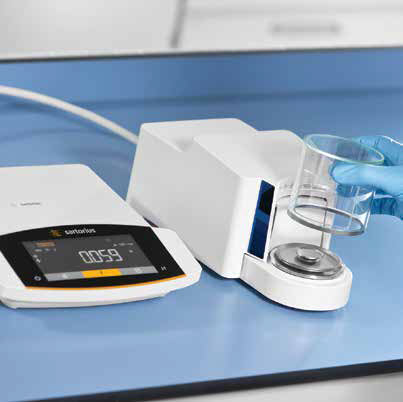Create a Solution for Every Laboratory with Modular Balances
A completely modular design enables scientists to configure a balance specifically suited to their applications
No two laboratories are alike, and this uniqueness is essential for new ideas, discovery and innovation. Unfortunately, despite the variability of sample types and protocols used across hundreds of different fields, many of the instruments used on a daily basis are only available in standard configurations. The same instrument used in pharmaceutical research for example, may be used for food science or environmental applications. While standard protocols and metrics are the foundation of scientific investigation, instruments that are customizable for the specific needs of a laboratory may improve functionality and ease of use. The laboratory balance is ubiquitous, and a newly developed modular version offers laboratories the power to configure a solution specific to their needs.
While it may seem like a simple device, the balance is a sophisticated instrument. The right solution should integrate a weighing module, user interface, draft shield, software and communication capabilities best suited to the laboratory. The Sartorius Cubis® II and QApp software are completely modular, allowing the operator to design a perfect fit for the laboratory.
Hardware modules for custom solutions
Weighing modules are available to suit every application from weighing micrograms of chemical compounds to kilos of ingredients for adhesive formulation, and it is important to select a module with a suitable capacity and readability. For an ultra-micro balance, this may translate to a maximum capacity of as little as 2 grams and a readability of 0.1 microgram. Alternatively, for larger scale applications with substances measured in kilograms, a high-capacity balance is required. Regardless of size, the weighing pan should have non-magnetic features, and the balance should be easy to disassemble and clean to prevent cross-contamination.
The user interface is essential for proper operation for any application. Configuring a balance with an intuitive touchscreen display is a simple way to improve functionality. The draft shield is also an important consideration, and different options can improve accuracy and safety. Glass panels coated with a conductive layer eliminate potential external transfer of electrostatic charge. Integrating a high-efficiency ionizer that eliminates electrostatic charges from samples and containers in seconds further improves accuracy. For laboratories working with toxic substances, configuring the balance with an infrared sensor enables touch-free manipulation of the draft shield to eliminate a potential point of contamination.
Working with an unlevelled balance is critical for accurate weighing. In a busy laboratory, even a small accidental movement of the scale can affect calibration. A balance designed with built- in sensors can alert the operator if re-leveling is required and built-in motors allow for automatic adjustments to ensure consistent, accurate results.
 |  |  |
Flexible software for evolving laboratory and regulatory needs
Software needs vary significantly between laboratories. Security and compliance may be essential for some laboratories, while density determination, residual dirt analysis, and percentage weighing may be more important functions for other laboratories. Sartorius QApp software can be installed based on theme, such as pharmaceutical, or as an all-inclusive solution. To keep up with constantly evolving laboratory and regulatory requirements, software must adapt and QApp software can be easily extended or updated as needs change.
When regulatory compliance is a primary concern, especially among pharmaceutical laboratories, instruments must be configured to protect data. Software configurations enable complete traceability, and support the requirements to achieve 21 CFR part 11 and EU Annex 11 compliance. Using time-stamped, tamper-protected audit trails, password rules, electronic signatures and safe data transfer, the Cubis® II with pharma software package is a fully compliant solution.
Easy integration
Lastly, a balance should integrate seamlessly into the laboratory. For those working with LIMS or ELN, integrating a balance can reduce potential errors associated with data transcription. Different interface ports, including USB, RS232, and Ethernet are used to integrate the balance with optional interfaces.
In some circumstances, printed data is required and a versatile system enables numerical or graphical display of results and statistics. An optional printer module offers a rapid, user-friendly option for printing. Alternatively, if a laboratory printer is available, integrating the balance to a network printer is a convenient solution.
The laboratory balance is an essential instrument in facilities worldwide. It is used for countless assays and processes, ranging from routine tasks to complex workflows. Despite this, many balances are only available in standard configurations that are well-suited for some, but not all, applications. The Sartorius Cubis® II balance is a completely modular instrument that can be configured for the specific needs of the laboratory. Thousands of potential hardware and software configurations make it possible to have your balance, your way.


